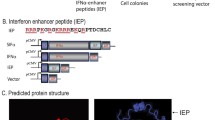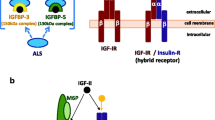Abstract
The aim of our study was to evaluate the effect of α-interferon (α-IFN) on cell growth and on the different IGF system components in a human non-small cell lung cancer line (Calu-6) in vitro. Our results confirm the release of IGF-I and IGF-II by these cells. The amount of IGF-II in conditioned media (10.25±3.95 nM/106 cells, mean±SE) was more than 10-fold higher than that of IGF-I. α-IFN treatment reduced IGF-II levels in the media, with a maximal effect between 1 and 10 U/ml (Δ% of control: −31 and −55%, respectively, p<0.05). IGF-I was significantly reduced at 0.5 U/ml (p<0.01). No difference, however, was observed in IGF mRNA expression between untreated and α-IFN treated cells. An increase in IGF-I and IGF-II intracellular levels in α-IFN treated cultures was observed, suggesting that α-IFN can regulate the transfer of these peptides into the cells. Furthermore, IGF type-I and particularly type-II receptor expression was increased after α-IFN treatment. IGFBP-3 was detected only in trace amounts in the conditioned media; however, it showed an increase after α-IFN treatment (+110% at 1 U/ml). IGFBP-3 mRNA expression showed a slight increase after treatment with 1 and 10 U/ml. α-IFN (1-10 U/ml) reduced the stimulatory effect of IGF-I on cell replication (p<0.01), inhibited (p<0.01) cell replication in untreated and in fetal calf serum (FCS)-stimulated cells, and increased apoptosis in Calu-6 cells. Our data suggest that α-IFN may exert its effects at the cellular level in part through modification of the local IGF system.
Similar content being viewed by others
References
Khandwala HM, McCutcheon IE, Flyvbjerg A, Friend K. The effects of Insulin-like growth factors on tumorigenesis and neoplastic growth. Endocr Rev 2000, 21: 215–44.
Nakanishi Y, Mulshine JL, Kasprzyk PG, et al. Insulin-like growth factor-I can mediate autocrine proliferation of human small cell lung cancer cell lines in vitro. J Clin Invest 1988, 82: 354–9.
Macaulay VM, Everard MJ, Teale JD, et al. Autocrine function for insulin-like growth factor I in human small cell lung cancer cell lines and fresh tumor cells. Cancer Res 1990, 50: 2511–7.
Reeve JG, Brinkman A, Hughes S, Mitchell J, Schwander J, Bleehen NM. Expression of insulin-like growth factor (IGF) and IGF-binding protein genes in human lung tumor cell lines. J Natl Cancer Inst 1992, 84: 628–34.
Minuto F, Del Monte P, Barreca A, et al. Evidence for an increased Somatomedin-C/Insulin-like growth factor I content in primary human lung tumors. Cancer Res 1986, 46: 958–88.
Minuto F, Del Monte P, Barreca A, Alama A, Cariola G, Giordano G. Evidence for autocrine mitogenic stimulation by somatomedin-C/insulin-like growth factor-I on an established human lung cancer cell line. Cancer Res 1988, 48: 3716–9.
Baserga R. The insulin-like growth factor I receptor: a key to tumor growth? Cancer Res 1995, 55: 249–52.
Ohlsson C, Kley N, Werner H, LeRoith D. p53 regulates insulin-like growth factor-I receptor expression and IGF-I-induced thyrosine phosphorylation in an osteosarcoma cell line: interaction between p53 and Sp1. Endocrinology 1998, 139: 1101–7.
Resnicoff M, Burgaud JL, Rotman HL, Abraham D, Baserga R. Correlation between apoptosis, tumorigenesis, and level of insulin-like growth factor I receptors. Cancer Res 1995, 55: 3739–41.
Wang Y, Sung Y. Insulin-like growth factor receptor-I as an anticancer target blocking transformation and inducing apoptosis. Curr Cancer Drug Targets 2002, 2: 191–207.
Lee CT, Park KY, Adachi Y, et al. Recombinant adenovirus expressing dominant negative insulin-like-growth factor-I receptor demonstrate antitumor effects on lung cancer. Cancer Gene Ther 2003, 10: 57–63.
Maloney EK, McLaughlin JL, Dagdigian NE, et al. An anti-insulin-like growth factor I receptor antibody that is potent inhibitor of cancer cell proliferation. Cancer Res 2003, 63: 5073–83.
Sachdev D, Hartell JS, Lee AV, Zhang X, Yee D. A dominant negative type I insulin-like growth factor receptor inhibits metastasis of human cancer cells. J Biol Chem 2004, 279: 5017–24.
Lee JS, Martin JL, Scott CD. Increased expression of the mannose6-phosphate/insulin-like growth factor-II receptor in breast cancer cells alters tumorigenic properties in vitro and in vivo. Int J Cancer 2003, 107: 564–70.
Chen Z, Landman N, Kang JX. Decreased expression of the mannose 6-phosphate/insulin-like growth factor-II receptor promotes growth of human breast cancer cells. BMC Cancer 2002, 2: 18.
Scharf J G, Braulke T. The role of the IGF axis in hepatocar-cinogenesis. Horm Metab Res 2003, 35: 685–93.
Kong FM, Anscher MS, Washington MK, Killian JK, Jirtle RL. M6P/IGF2R is mutated in squamous cell carcinoma of the lung. Oncogene 2000, 19: 1572–8.
Jones IJ, Clemmons DR. Insulin-like growth factors and their binding proteins: biological actions. Endocr Rev 1995, 16: 3–34.
Oh Y, Muller HL, Lamson G, Rosenfeld RG. Insulin-like growth factor (IGF)-independent action of IGF-binding protein-3 in Hs578T human breast cancer cells. Cell surface binding and growth inhibition. J Biol Chem 1993, 268: 14964–71.
Rajah R, Valentinis B, Cohen P. Insulin-like growth factor binding protein-3 induces apoptosis and mediates the effects of transforming growth factor-beta 1 on programmed cell death through a p53-and IGF-independent mechanism. Biol Chem 1997, 272: 12181–8.
Buckbinder L, Talbott R, Velasco-Miguel S, et al. Induction of the growth-inhibitor IGF-binding protein-3 by p53. Nature 1995: 646–9.
Denz H, Lechleitner M, Marth C, et al. Effect of human recombinant alpha 2 and gamma interferon on the growth of human cell lines from solid tumors and hematologic malignancies. J Interferon Res 1985, 5: 147–57.
Kalvakolanu DV, Borden EC. An overview of the interferon system: signal transduction and mechanisms of action. Cancer Invest 1996, 14: 25–53.
Einhorn S, Strander H. Interferon treatment of human malignancies: a short review. Med.Oncol. Med Oncol Tumor Pharmacother 1993, 10: 25–9.
Borden EC, Parkinson D. A perspective on the clinical effectiveness and tolerance to interferon-alpha. Semin Oncol 1998, 25: 3–8.
Oberg K, Eriksson B. Medical treatment of neuroendocrine gut and pancreatic tumors. Acta Oncol 1989, 28: 425–9.
Vitale G, Taglaferri P, Caraglia M, et al. Slow release lanreotide in combination with interferon alpha 2b in the treatment of symptomatic advanced medullary thyroid carcinoma. J Clin Endocrinol Metab 2000, 85: 983–8.
Swisher SG, Roth JA, Carbone DP. Genetic and immunologic therapies for lung cancer. Semin Oncol 2002, 1 (Suppl 4): 95–101.
Yasuoka Y, Naomoto Y, Yamatsuji T, et al. Combination of tumor necrosis factor alpha and interferon alpha induces apoptotic cell death through a c-myc-dependent pathway in p53 mutant H226br non-small-cell lung cancer cell line. Exp Cell Res 2001, 271: 214–22.
Yamamoto-Yamaguchi Y, Okabe-Kado J, Kasukabe T, Honma Y. Induction of apoptosis by combined treatment with differentiation-inducing agents and interferon-alpha in human lung cancer cells. Anticancer Res 2003, 23: 2537–47.
Arkins S, Rebeiz N, Brunke-Reese L, Biragyn A, Kelley KW. Interferon gamma inhibits macrophage insulin-like growth-factor-I synthesis at the transcriptional level. Mol Endocrinol 1995, 9: 350–60.
Ilvesmaki V, Jaattela M, Saksela E, Voutilainen R. Tumor necrosis factor alpha and interferon gamma inhibit insulin-like growth factor II gene expression in human fetal adrenal cell cultures. Mol Cell Endocrinol 1993, 91: 59–65.
Martin DM, Carlson RO, Feldman EL. Interferon gamma inhibits DNA synthesis and insulin-like growth factor-II expression in human neuroblastoma cells. J Neurosci Res 1993, 34: 489–501.
Breuhanhn K, Vreden S, Haddad R, et al. Molecular profiling of human hepatocellular carcinoma defines mutually exclusive interferon regulation and insulin-like growth factor II overexpression. Cancer Res 2004, 64: 6058–64.
Hwa V, Little B, Kofoed EM, Rosenfeld RG. Transcriptional regulation of insulin-like growth factor-I by interferon-gam-ma requires STAT-5b. J Biol Chem 2004, 279: 2728–36.
Oliveira MR, Ohnuma L, Bendit I, Dorlhiac-Lacer P, Gian-nella-Neto D. Interferon-alpha therapy increases type I insulin-like growth factor receptor expression on lymphoid cells from patients with chronic myelogenous leukemia. Leuk Res 2001, 21: 711–7.
Shalita-Chesner M, Katz J, Shemer J, Werner H. Regulation of insulin-like growth factor-I receptor gene expression by tumor necrosis factor-alpha and interferon-gamma. Mol Cell Endocrinol 2001, 176: 1–12.
Telasky C, Tredget EE, Shen Q, et al. IFN-alpha 2b suppresses the fibrogenic effects of insulin-like growth factor-I in dermal fibroblasts. J Interferon Cytokine Res 1998, 18: 571–7.
Hill DJ, Petrik J, Arany E, et al. Insulin-like growth factors prevent cytokine-mediated cell death in isolated islets of Langherhans from pre-diabetic non-obese diabetic mice. J Endocrinol 1999, 161: 153–65.
Jansen M, van Schaik FMA, Ricker AT, et al. Sequence of cDNA encoding human insulin-like growth factor-I precursor. Nature 1983, 306: 609–11.
Jansen M, Van Schaick FM, van Tol H, Van den Brande JL, Sussenbach JS. Nucleotide sequence of cDNAs encoding precursors of human insulin-like growth factor II (IGF-II) and an IGF-II variant. FEBS Lett 1985, 179: 243–6.
Lund PK, Moats-Staas B.M, Hynes M, et al. Somatomedin-C/Insulin-like growth factor-I and insulin-like growth factor II mRNAs in fetal and adult tissues. J Biol Chem 1986, 261: 14539–44.
Mita K, Nakahara M, Usui T. Expression of the insulin-like growth factor system and cancer progression in hormone-treated prostate cancer patients. Int J Urol 2000, 7: 321–9.
Moorehead RA, Sanchez OH, Khokha R. Transgenic overexpression of IGF-II induces spontaneous lung tumors: a model of human lung adenocarcinoma. Oncogene 2003, 22: 853–7.
Pavelic J, Pavelic L, Karadza J, et al. Insulin-like growth factor family and combined antisense approach in therapy of lung cacinoma. Mol Med 2002, 8: 149–57.
Clemmons DR. Insulin-like growth factor-1 and its binding proteins. In: De Groot LJ, Jameson JL eds. Endocrinology. Philadelphia: Saunders. 2001, 439–60.
Lee HY, Chun KH, Liu B, et al. Insulin-like growth factor binding protein-3 inhibits the growth of non-small cell lung cancer. Cancer Res 2002, 62: 3530–7.
Katz J, Nasatzky E, Werner H, Le Roith D, Shemer J. Tumor necrosis factor α and interferon γ-induced cell growth arrest is mediated via insulin-like growth factor binding protein-3. Growth Horm IGF Res 1999, 9: 174–8.
Author information
Authors and Affiliations
Corresponding author
Rights and permissions
About this article
Cite this article
Del Monte, P., Laurino, C., Arvigo, M. et al. Effects of α-interferon on insulin-like growth factor-I, insulin-like growth factor-II and insulin-like growth factor binding protein-3 secretion by a human lung cancer cell line in vitro . J Endocrinol Invest 28, 432–439 (2005). https://doi.org/10.1007/BF03347224
Accepted:
Published:
Issue Date:
DOI: https://doi.org/10.1007/BF03347224




